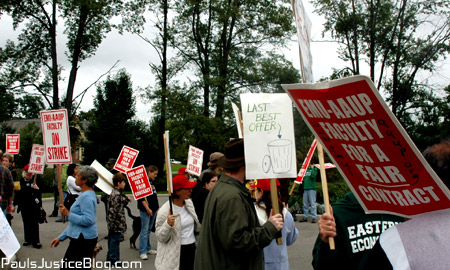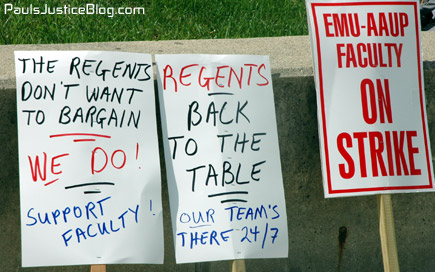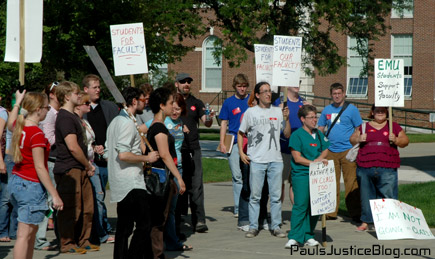Columbus Day: A Critique of Celebrating Colonialism
This is the introduction to Chapter 7 on Victims and Victimology of the Class, Race, Gender and Crime book I co-authored (available at the end of this month).
Because the deprivations of some minorities have been so extensive and/or are so profound, some argue that these social relations or conditions amount to “genocide,” a powerful word used to describe extreme cases of mass violence and victimization whose derivation comes from the Latin cide (kill) and the Greek genos (race or tribe). The underlying concept of genocide involves an attempt to exterminate a group that shares common characteristics and a common identity. Hence, charging genocide is claiming great harm and victimization that not only indicts a group for committing and/or standing by in the face of mass violence, but it also confers a moral authority on the victims to be heard and to demand change.

The study of genocide has been confounded by a long and pervasive history of denial (Chalk and Jonassohn 1990). For example, traditional criminology takes great interest in serial killers and mass murderers but typically ignores or excludes genocide and other violations of human rights as part of the accepted disciplinary areas of examination (there’s even little interest in understanding a political mass murderer like bin Laden). In the context of victimology and victimization, the denial and exclusion are good reasons to review the claims that the majority population of the U.S. has committed genocide involving both Native Americans and African Americans.
Many citizens of the U.S. consider charges of genocide made by minority populations to be overstated at best. They tend to associate genocide with the Holocaust in Nazi Germany, which creates a distorted standard because it is an extreme case rather than a more typical one. The core concept, however, is “an attempt to exterminate a racial, ethnic, religious, cultural, or political group, either directly through murder or indirectly by creating conditions that lead to the group’s destruction” (Staub 1989, p. 8). Such destruction encompasses “not only killing but creation of conditions that materially or psychologically destroy or diminish people’s dignity, happiness, and capacity to fulfill basic material needs” (Staub 1989, p. 25).
Every year on Columbus Day readers might notice signs protesting “500 years of genocide.” Like many claims of genocide, this one is met with much denial. Indeed, for the 500th anniversary of Columbus arriving in North America, the National Endowment for the Humanities refused to fund any film that “proposed to use the word ‘genocide,’ even in passing to explain the subsequent liquidation of America’s indigenous population” (Churchill 1997, p. 5). Similar thinking has precluded much discussion about charges that Columbus himself was an “agent of genocide” and that the colonization process he set in motion has resulted in genocidal processes.
In fact, Columbus understood his own life “in apocalyptic terms” and even “announced that he himself was the Messiah prophesied by Joachim, a twelfth-century Italian mystic” (Lamy 1996, p. 46). Diaries and letters of Columbus show that he was expecting to encounter wealth belonging to others, and his stated purpose was “to seize this wealth, by whatever means necessary and available, in order to enrich both his sponsors and himself” (Churchill 1997, p. 85). In sum, Columbus “not only symbolizes the process of conquest and genocide which eventually consumed the indigenous people in America, but bears the personal responsibility of having participated in it” (ibid).
Whether genocide is a fair characterization of the next 500 years revolves around Staub’s definition of genocide as involving the indirect murder through the creation of conditions leading to the group’s social destruction. Lemkin, the man who coined the term genocide, understood genocide to be in the “destruction of the essential foundations of the life” of the group and undermining the integrity of the group’s basic institutions, which produces the “destruction of the personal security, liberty, health, dignity, and even the lives of the individuals belonging to such groups” (in Kuper 1985, p. 9). Moreover, very few instances of mass murder that have been acknowledged to be genocide involve the actual elimination of a group. Thus, the state of Israel and the presence of Jews worldwide today do not undermine a claim that the Holocaust was genocide.
With Native Americans, the low point of the population was down 90 percent from the level before the time Columbus arrived (Churchill 1997). Some population fluctuation was inevitable, but the drastic decline here is related to a number of practices that involved direct murder as well as indirect attacks on the well-being and cultural integrity of Native Americans. Consider, for instance, the aggressive appropriation (theft) of land that included forced marches—such as the Trail of Tears—that had a high death toll because hunger, exhaustion, and exposure to inclement weather killed many women, children, and the elderly.
The removal of Native Americans from land that was sacred and had cultural significance eroded their cultural integrity, and their placement on desolate land further undermined the essential foundations of life. This process of forced relocation recurred multiple times with the expansion in the population of white settlers or the discovery of mineral wealth on what was thought to be wasteland given to Native Americans (Lazarus 1991; Weyler 1992). Today, there are still substantial problems with reservations being located on inhospitable land, which can also be a site for toxic and radioactive materials (Eichstaedt 1994).
For more information, see Dee Brown's Bury My Heart at Wounded Knee
To control the Native American population in the 1800s, settlers intentionally gave them disease-infested blankets that would kill large numbers who did not have immunity to European diseases. In addition, children were taken—sometimes at gunpoint—and put into boarding and reform schools where they were deprived of access to their culture and native language. Indeed, these children were punished for doing anything “Indian” and were taught to be ashamed of their heritage. Even today, many Native Americans in prison are denied access to culturally appropriate practices such as the sweat lodge and are coerced into programs such as Alcoholics Anonymous that have Christian foundations, thus further eroding their cultural integrity (Little Rock 1989 16p .pdf via Journal of Prisoners on Prisons).
The U.S government—the representative of the American people—has broken every treaty it has made with the Native Americans (Lazarus 1991). The refusal to honor treaties negotiated in good faith by the native peoples has denied them rights to land, resources, and sovereignty in many ways that have imposed, both historically and currently, hardship and have destroyed their personal security, liberty, health, and dignity. Although several cases involving broken treaties have resulted in symbolic reparations for Native Americans, the ongoing problems remain.
Indeed, most tribes, even on reservations, have little in the way of sovereignty and are subject to state and federal control. The tribal decision-making bodies recognized by tribal members are often not the same as the leaders officially recognized by the federal government. In addition, the Bureau of Indian Affairs has come under scathing criticism for being corrupt and not having the best interest of Native Americans at heart in administering their affairs (Lazarus 1991; Weyler 1992). In the latter part of the 20th century, activism on the part of Native Americans, such as the American Indian Movement (AIM), was met with illegal surveillance and at times violent repression by the FBI and other law enforcement agencies (Churchill and Wall 1990a, 1990b - see also 2002 audio CD).
Although most of the direct killing of Native Americans is part of the past, the place accorded them by the white majority is one that destroys the essential foundations of their life. While the ongoing effort to undermine the integrity of Native American’s basic institutions has occasionally met with spirited and creative acts of resistance to domination and colonization, these demonstrations have failed because of the unaltered structural relations of inequality between the majority of whites and marginalized minorities. What the National Advisory Commission on Civil Disorder noted about inner-city ghettos applies equally well to reservations:
What white Americans have never fully understood— but what the Negro can never forget—is that white society is deeply implicated in the ghetto. White institutions created it, white institutions maintain it, and white society condones it (quoted in Pinkney 1984, p.78).
In each case, whatever the intentions or consciousness of white society, both the inner city and reservations are places of extreme social deprivation and violence. Indeed, as Wilhelm (1970, p. 334) noted, “as the races pull apart into lifestyles with greater polarity, the Black ghetto evolves into the equivalent of the Indian reservation.” Obvious questions thus arise as to whether the history or current conditions of blacks can be described as genocide as well.
My earlier blog entry Judge Removed for Indian Trust Case for Saying Dept of Interior Is Racist (12 July 2006)
More history on the Indian Trust case
Let me be a free man, free to travel, free to stop, free to work, free to trade where I choose, free to choose my own teachers, free to follow the religion of my fathers, free to talk, think and act for myself - and I will obey every law or submit to the penalty.
quoted in Russell Means, Where White Men Fear to Tread |









